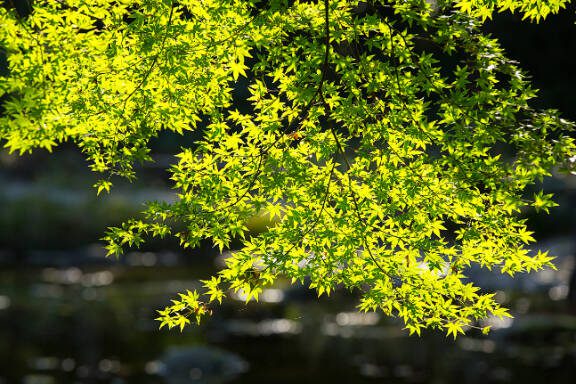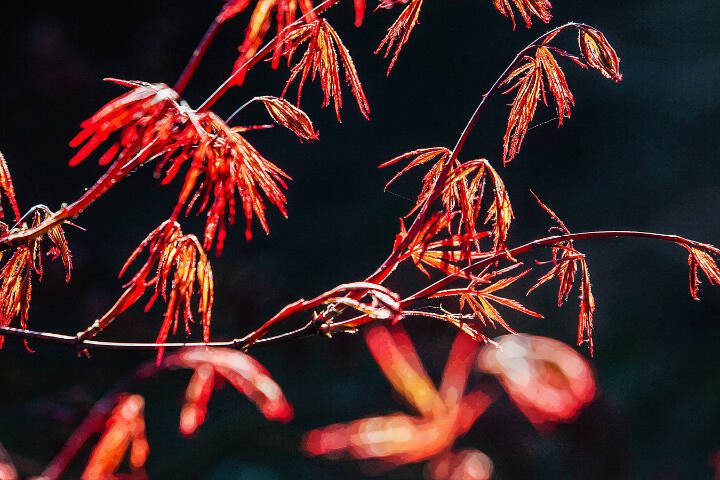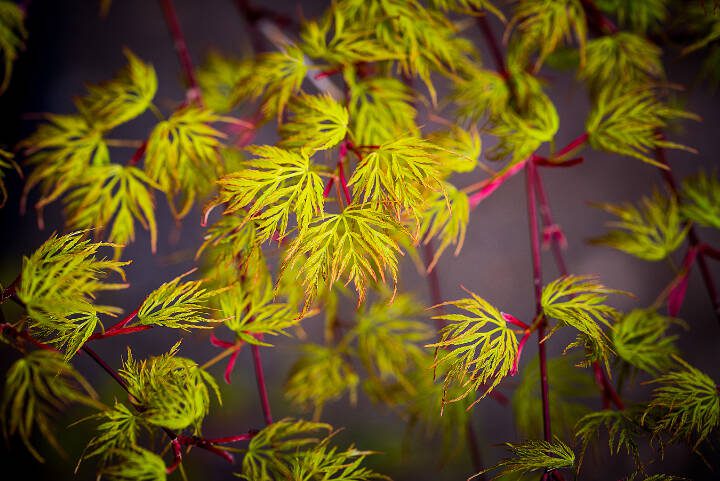By Trevor Cameron / The Golfing Gardener
Japanese maples come in all sorts of shapes, sizes, colors, growth habits and foliage types, offering the home gardener myriad choices to suit their individual taste.
All of these trees get outstanding autumn color, but gardeners should note their spring foliage tones, as well. Here at Sunnyside Nursery, we stock more than 120 cultivars of these garden beauties, and our patrons are often pleasantly surprised with the bright yellow, orange, red, purplish, pinky or simple, bright pea-green options.
As they begin to leaf out for the season, now is the perfect time to pause and admire the fabulous spring color and contrast they provide.
Maples are excellent choices for focal points in the landscape — true specimens to be enjoyed in all seasons, if you ask this gardener. Many of them will also thrive in a container for a number of years, as well, offering plant addicts like me who are out of garden bed space another avenue to grow yet another one. Everyone has empty pots or room to add a pot somewhere, right?
Either way, Japanese maples thrive in our specific climate when two main issues are addressed:
Drainage — The kiss of death for these trees is poor drainage and/or heavy clay soils. When the water table comes up in the winter rainy season, this often ends in a rapid spring decline from a disease called verticillium wilt. I see this here and there, year after year, and honestly have fought this in spots in my own yard, right in Everett, for 20 years. Please ensure you have adequate drainage to grow them; planting on gentle berms of raised soil may help, as well.
Placement — Paying attention to your sun-shade situation is important with all plants, and Japanese maples are no exception. All will thrive as understory trees, or in part sun and part shade. Many with red to burgundy foliage will flourish in all-day hot sun, while other variegated or reticulated cultivars enjoy a lot more shade. In addition, look at your site to determine the ultimate size that you can handle. With so many options, choose wisely and avoid butchering your specimen down the road in order to fit it into an area that is simply too small.
Here at the nursery, and in my own yard, I can see bright colors starting to pop everywhere. This to me is what Japanese maples are all about. They offer distinct spring foliage options, then evolve to other colors through spring and summer before finally lighting up our landscapes with glowing fall colors.
There are far too many good choices, in all honesty, but here are a few flavors I recommend — offering you a variety of color choices and growth habit options to ponder for your outdoor spaces:
Shindeshojo — To me, this is still the quintessential spring-foliage maple with bright, fuchsia-red fading into lightly variegated green foliage in late spring and summer. A great specimen choice for a mostly sunny garden.
First Flame — Part of the newer Pacific Rim collection from Iseli Nursery, it sports outstanding fiery, orangey-red spring foliage that turns more green over summer. A larger growing option for sun.
Orangeola — A sweet laceleaf (weeping) choice with orangey-red spring color and all kinds of character with its twisting and weeping structure. Color will continue to impress all summer long, with a mix of greens and orangey-red tip growth.
Mikawa Yatsubusa — To me, this is one of the best maples around, with super bright, pea-green spring color, red petioles and outstanding layered structure. The perfect choice for both pots and in-ground planting in sun or part shade.
Mikazuki — The “Crescent Moon” maple is a striking, reticulated-foliage option with a showy combo of pink, red and green leaves in spring, staying nicely variegated all summer. An excellent choice for morning sun to shade, or in a woodland setting.
Ryusen — Another bright, pea-green spring option, but this one grows in a unique weeping habit and can be trained almost like a vine, if you like to have some garden fun and grow something unique.
Summergold — Outstanding bright yellow spring foliage fades into limey-yellow for the summer. A great choice for a large understory specimen with partial shade.
Geisha Gone Wild — A fun variegated-foliage option with hot pinks, white and green in spring that continues to show good color all summer. A manageable size for yard placement and good in pots, as well.
You will notice I mentioned no specific red ones for spring; that is because they are all spectacular. From Fireglow and Moonfire to Rhode Island Red, Twombley’s Red Sentinel and many more, all are simply stunning from spring through summer. And right now, in particular, a red, burgundy or purple flavor is sure to pop against all the greens in our spring landscapes.
Japanese maples were one of my first plant addictions, and as a full-fledged “plantophile” these days, I find that they remain near and dear to my heart.
Years ago, I coined the term “acer palmatumitis,” a mythical contagious disorder that involves the addiction to all things Japanese maple. You will know if you have it, as I do, because there is always room for just one more of these beauties somewhere in your landscape.
Free classes
Sunnyside Nursery in Marysville will host “New & Exciting Plants For 2024” at 10 a.m. on Saturday, April 6, and “Japanese Maples: The Tree For All Seasons” at 10 a.m. on Saturday, April 13. For more information or to sign up, go to www.sunnysidenursery.net/classes.
Trevor Cameron is a certified professional horticulturist (CPH) and serves as general manager for Sunnyside Nursery in Marysville. He can be reached at sunnysidenursery@msn.com.
Talk to us
> Give us your news tips.
> Send us a letter to the editor.
> More Herald contact information.



























